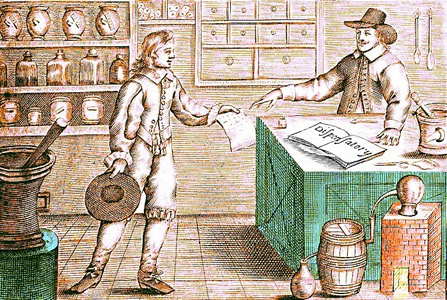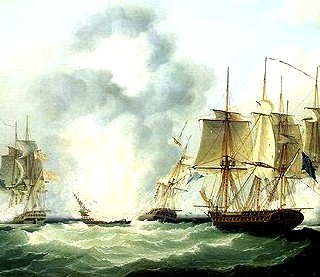
Sea Surgeon's Dispensatory: 1 2 3 4 5 6 7 8 9 10 11 12 13 14 15 16 17 18 19 20 21 22 23 24 25 Next>>
The Sea Surgeon's Dispensatory, Page 1
Medicines were a very important part of sea surgery, even though medicinals were not typically considered part of a surgeon's role. John Woodall, author of the first English book written specifically for sea surgeons - the surgions mate - devotes almost 50% of his main text in the 1617 edition specifically to the nearly 300 medicines he suggests a sea surgeon have at hand.1 This page count does not include medicinal material embedded in the descriptions of operations and diseases. Although it is not technically organized as such, Woodall's material on medicines provide a sort of Dispensatory - a book advising on how and for what medicines were to be used (or dispensed) at sea.

The Expert Doctor's Dispensary, by Pierre Morel, Wellcome Images, frontispiece (1657)
Medicines at this time were made up of anything and everything found in the environment. Andrew Wear explains, "Everything in the created world could have a medicinal use. Animals, minerals and especially plants were potential medicines. Their numbers were huge, as were the numbers of objects and organisms that God created."2
Three sea surgeons provided lists of medicines tailored for use by sea surgeons from this period. Each list includes a variety of animals, minerals and plants. The largest is Woodall's 299 medicines printed in 1617 and then reprinted with some small changes in 1639 with the addition of four more medicines and printed again in 1655. Second, we have sea surgeon John Moyle's 'Exemplary Invoyce' in 1693 of 152 plants and plant-based medicaments and 29 compositions to be made as needed for which he gives the prescription.3 Last is Dr. John Tweedy's Bill for Medicines for a privateering voyage undertaken in 1743 containing 118 items consisting primarily of plant-based medicines.4 It is notable that the quantity of medicines recommended given by each subsequent author decreased, hinting that many of the medicines originally thought necessary were not found to be so.
There is a lot of material to cover in explaining medicines and this article has been broken in to three parts. The first part will examine the sea surgeon's role in medicine, followed by a history of important figures in medicine and the medicines themselves - discussing their uses and how they were obtained.
The second part will discuss the history and importance of the herbals, pharmacopoeias and dispensatories, the various organizational schemes those books used and why they were important and will finish with medicinal concerns unique to sea surgeons.
The last section will use the material taken from Woodall, Moyle and Tweedy to build the sea surgeon's dispensatory, listing the medicines the three of them recommended a sea surgeon have on hand for long voyages. It will include information on which of the various classes each medicine belonged to, the prescription for compound medicines and an explanation of the uses of each medicine, focusing particularly on comments made by the sea surgeons.
1 The actual ration is 46.7%, a figure that will be explained in detail later in this article. For actual sections see John Woodall, the surgions mate, 1617, pp. 40-124, 224-32, 250 & pp. 271-91 (irregular pagination - should be pages 251-71), 292-6, 297-307, 313-28 & 329-37; 2 Andrew Wear, Knowledge & Practice in English Medicine, 1550-1680, p. 78; 3 John Moyle, The Sea Chirurgeon, 1702, p. 10-5, 17-20, 23-6, 28-33; 4 John Franklin Jameson, ed., "158. John Tweedy’s Bill for Medicines. November 8, 1743". Privateering and Piracy in the Colonial Period Illustrative Documents, p. 456-61
Sea Surgeons as Apothecaries
"The absolute necessity for the practice of physic [medicine] in ships had been tacitly accepted since 1626 when internal medicines were added to the sea-surgeon’s stores; the generals-at-sea and the government itself realized how much an epidemic during the Dutch War had imperiled the military position" [the Second Anglo-Dutch War, 1665 - 1667, when the plague contributed to the destruction of the fleet at Chatham by the Dutch fleet in June 1667.]" (John J. Keevil, Medicine and the Navy 1200-1900: Volume II – 1640-1714, p. 38)

Artist: Jan Steen
A Physician and His Patient (17th c.)
On land, the practice of medicine essentially fell to four types of practitioners during the golden age of piracy - three officially sanctioned practitioner branches organized in guild-like fashion and one unofficial class of practitioner containing a variety of non-sanctioned medical practitioners.
The three official branches of medicine included the physician, the surgeon and the apothecary. At the top of this hierarchy was the physician, represented by the Royal College of Physicians in London. Their role was largely theoretical, involving diagnosis, attendance and advice1.
Next were the apothecaries, who belonged to the Society of Apothecaries. "The physician prescribed; the apothecary dispensed."2 The apothecaries described their craft as 'a Mystery', which "gave them the status of assistants to the physicians... they were required to have a skilled knowledge of plants and herbs, roots and drugs, and to be qualified in the theory and practice of chemistry."2
Last were the surgeons, who were represented by the Company of Barber-Surgeons. In broad terms, surgeons did all the hand work on a patient's body. The surgeons were broadly divided into two sub-types in London during the golden age of piracy: "'True' surgeons [who] concerned themselves with major operations... [and] barber-surgeons [who] were wound doctors who also performed bloodletting, cupping, the extraction of teeth, and the management of fractures, dislocations, and external ulcers."4
The fourth category of medical practitioners were not represented by a guild or society and basically included everyone else who interested themselves in the practice of medicine - "the Bonesetters, the Herbalists, the Midwives, and of course, the vast legion of Quacks"5. While not officially recognized, many of them provided a useful function, working for those who were not able to to afford the official route to health.

Artist: Francis Sartorius
Four Frigates Capturing Spanish Treasure Ships (1807)
That was on land. The story was quite different at sea. Most naval vessels had neither physicians nor apothecaries on board; they only had surgeons. It wasn't until 1691 that naval physicians were even assigned to manage the naval surgeons for the English home ports of Chatham, Deal, Portsmouth and Plymouth.6
Somewhat lower down on the scale were merchant vessels and privateers. Few (if any) of them would gone to the expense of employing an apothecary or physician. If they had a medical man on board, he was the one most likely to be useful in the majority of problems they would encounter - the surgeon.
Since the surgeons were often the only ones with medical training and authority on a vessel, surgeons had to assume the roles and responsibilities of physician and apothecary when their craft was necessary. Although many land-based surgeons did practise some medicinal prescription (particularly country doctors practising outside of London7), it was a less familiar area of knowledge for them. This may explain why Woodall devotes almost half of his manual to information on medicines - it was particularly necessary to give his readers guidance in this area.
1,2 Roy Porter, "The Patient in England, c. 1660-c. 1800", Medicine in Society, edited by Andrew Wear, 1992, p. 92; 3 Leonard A.G. Strong, Dr. Quicksilver, 1660-1742; The Life and Times of Thomas Dover, M.D., 1955, p. 63; 4 Albert S. Lyons and R. Joseph Petrucelli II, Medicine: An Illustrated History, p. 454-5; 5 Strong, p. 66; 6 Kevin Brown, Poxed and Scurvied: The Story of Sickness and Health at Sea, 2011, p. 47; 7 Porter, p. 93

